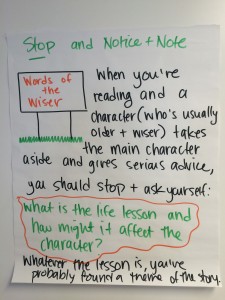Book Review: Notice & Note
 Over the summer, I learned I would be teaching a class of struggling 6th grade readers. They would have me for regular ELA, but they would also travel together to a reading support class right after mine. I did not have experience teaching a class solely of struggling learners, so I reached out to a colleague on the west side of the state, Megan Perrault (@megankperreault), and asked her for recommendations about how I might approach this challenge.
Over the summer, I learned I would be teaching a class of struggling 6th grade readers. They would have me for regular ELA, but they would also travel together to a reading support class right after mine. I did not have experience teaching a class solely of struggling learners, so I reached out to a colleague on the west side of the state, Megan Perrault (@megankperreault), and asked her for recommendations about how I might approach this challenge.
Megan is an amazing reading teacher, and she recommended Kylene Beers and Robert E. Probst’s Notice & Note: Strategies of Close Reading. This book had been on my “to read” list and was quickly moved up in the queue based on Megan’s recommendation.
Notice & Note initially impressed me with the thoroughness with which Beers and Probst researched and tracked common elements within young adult novels. I also appreciated how they piloted and revised their work based on the experiences of real teachers in real classrooms.
The premise of Notice & Note is this: the majority of YA novels have six common elements, which Beers and Probst call “signposts.” If students can notice and think about why these signposts are showing up, they are doing the work of close reading and are understanding the text better. Each signpost has one question that readers can ask themselves, to help them think deeply about why that particular signpost is showing up. This really helps to focus students’ thinking.
The Signposts
In a nutshell, the signposts are as follows:
- Contrasts & Contradictions—When the character does something out of character
- Words of the Wiser—When an older, wiser character gives serious advice
- Again & Again—Something that keeps showing up
- Aha Moment—When the character suddenly realizes something
- Memory Moment—When the story is interrupted to tell the reader a memory
- Tough Questions—When the character asks himself/herself really difficult questions
I was originally planning to only introduce the signposts to my 6th grade class, but once I saw the power they held, I also began using them with my 8th grade readers. Both grade levels are engaged with the signposts and are thinking deeply about the texts they are reading. Maybe the best testament to the power of noticing the signposts is when students get that look of discovery on their face and call me over because they have noticed a signpost on their own.
After I had read Notice & Note, Megan and I were at professional development together, and she mentioned the Notice & Note Facebook group. Now, if you know me, you know I’m all about Twitter when it comes to anything related to teaching.
But this Facebook community is amazing! The group has a very active 8,600+ members, and I navigate the page often. As someone who is teaching the signposts for the first time, the resources on this page have been invaluable. Members have shared tons of files and their experiences with the signposts. And for each signpost, I have found either a picture book or video clip to help introduce the concept. These have been a big hit with students and have helped them understand the concepts prior to working with them in their novels.
Just this past fall, Beers and Probst published Reading Nonfiction: Notice & Note Stances, Signposts, and Strategies. Stay tuned for a review!
 Jianna Taylor (@JiannaTaylor) is an ELA and Title 1 teacher at Orchard Lake Middle School in West Bloomfield. She is a member of the AVID Site Team and Continuous School Improvement Team at her school, among other things. She is also a MiELA Network Summer Institute facilitator and member of the OWP Core Leadership Team. Jianna earned her bachelor’s degree from Oakland University and her master’s degree from the University of Michigan. She also writes reviews of children’s books and young adult novels for the magazine Library Media Connection.
Jianna Taylor (@JiannaTaylor) is an ELA and Title 1 teacher at Orchard Lake Middle School in West Bloomfield. She is a member of the AVID Site Team and Continuous School Improvement Team at her school, among other things. She is also a MiELA Network Summer Institute facilitator and member of the OWP Core Leadership Team. Jianna earned her bachelor’s degree from Oakland University and her master’s degree from the University of Michigan. She also writes reviews of children’s books and young adult novels for the magazine Library Media Connection.

